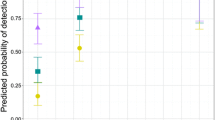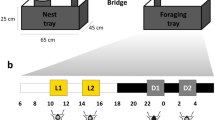Summary of part I.
Variation in worker locomotor activity and worker behaviour inMyrmica scabrinodis has been experimentally investigated.
-
1.
Three worker jobs are recognised. Workers doing these jobs have been designated nurses, domestics, and foragers. Differences in locomotor activity, behaviour, brood rearing, size, and nest-building capacity have been recorded.
-
2.
Worker-job-preference (worker polyethism) has been demonstrated forming a dynamic system.
-
3.
Worker-job-preference changes with age in the sequence nurse → domestic → forager.
-
4.
Ethologically domestics are most plastic and are preferential nest builders.
-
5.
Cuticular melanisation increases as ethal changes occur. The significance to be attached to the rate of cuticular melanisation, to size variation and to ethal differences between melanic groups is discussed.
Résumé de la première partie
Étude expérimentale chezMyrmica scabrinodis du comportement et de l'activité locomotrice des ouvrières.
-
1.
On reconnaît trois tâches aux ouvrières, qui sont dènommèes sur cette base nourrices, mènagères, fourrageuses.
On les compare au point de vue de leur activité locomotrice, de leur comportement, de l'évage de la couvée, de leur taille et des moyens de construction de nid.
-
2.
On dèmontre une liaison prèfèrentielle ouvrière-tâche (polyèthisme) sous forme de système dynamique.
-
3.
La liaison ouvrière-tâche se transforme avec l'âge selon la suite nourrice →r mènagère →r fourrageuse.
-
4.
Les mènagères s'adaptent mieux aux changements èthologiques et marquent une prèfèrence pour la construction des nids.
-
5.
Le mèlanisme de la cuticule s'accentue avec les changements de moeurs.
On discute les valeurs respectives du taux de mélanisme, de la variation de taille et des divergences éthologiques des différents groupes mélaniques.
Resumen. — Sección I
De forma experimental, se ha investigado la variación en la locomoción y comportamiento de la trabajadoraMyrmica scabrinodis.
-
1.
Se reconocen tres labores entre las trabajadoras y aquellas que las ejercen se dividen en: domésticas, enfermeras y forajeras. Se anota una differencia entre su actividad, comportamiento, tamaño, cuidado de su cria y capacidad de anidación.
-
2.
Preferencia de labor (polyetismo) demuestra un sistema dinámico.
-
3.
Esta preferencia cambia con su edad: de enfermera → domestica → forajera.
-
4.
Etologicamente, las domésticas son las más maleables, siendo preferentemente anidadoras.
-
5.
Su melanisación cuticular aumenta al ocurrir los cambios etales. Se comenta sobre el significado ateniente a la proporción de melanisación cuticalar, variación de tamaño y diferencia etal entre los grupos melánicos.
Similar content being viewed by others
References
1951.Brian (M. V.). — Ant culture for laboratory experiment (Ent. mon. Mag.,87, 134–6).—Brian (M. V.). 1954. Studies of caste differentiation inMyrmica rubra L. I. The growth of queens and males (Insectes sociaux,1, 101–122).—Brian (M. V.), 1955. Studies of caste differentiation inMyrmica rubra L. III. Larval dormancy, winter size, and vernalization (Insectes sociaux,2, 85–114).
1949.Brian (M. V.), Brian (A. D.). — Observations on the taxonomy of the antsMyrmica rubra L. andM. laevinodis Nylander (Hymenoptera: Formicidae) (Trans. R. ent. Soc. Lond.,100, 393–409).
1910.Buckingham (E. N.). — Division of labour among ants (Proc. Amer. Acad. Arts Sci.,46, 423–507.
1950.Carthy (J. D.). — Odour trails ofAcanthomyops fuliginosus (Nature, Lond.,166, 152).
1943.Chauvin (R.). — Deux appareils pour l'étude de l'activité de petits animauxBull. Soc. Zool. Fr.,68, 53–56).
1937.Chen (S.). — Social modification of the activity ofants in nest building —: The leaders and followers among ants in nest building (Physiol. Zool.,10, 420–455).
1953.Creighton (W. S.). — New data on the habits ofCamponotus (Myrmaphaenus) ulcerosus Wheeler (Psyche,60, 82–4).
1905.Doflein (F.). — Beobachtungen an den Weberameisen (Oecophylla smaragdina) (Biol. Zbl.,25, 497–507).
1931.Ehrhardt (S.). — Ueber Arbeitsteilung bei Myrmica und Messor-arten (Z. Morph. Okol. Tiere,20, 755–812).
1927.Eidmann (H.). — Die Sprache der Ameisen (Russk. zool. Zh.,7, 39–48).
1874.Forel (A.). — Les Fourmis de la Suisse (N. Denkschr. Schweiz. Ges. Naturw.,26 1–452).—Forel (A.). 1921.Le Monde Social des Fourmis, Geneva.
1953.Fox (D. L.). —Animal Biochromes and Structural Colours. Cambridge.
1924.Heyde (K.). — Die Entwicklung der psychischen Fähigkeiten bei Ameisen und ihr Verhalten bei abgeanderten biologischen Bedingungen (Biol. Zbl.,44, 623–654).
1952.Lindauer (M.). — Ein Beitrag zur Frage der Arbeitsteilung im Bienenstaat (Z. vergl. Physiol.,34, 299–345 etBee world,34, 63–73 et 85–90).
1936.Fison (L.). —Histochimie animale. Paris.
1954.Muir (D. A). — AntsMyrmica rubra L. andM. scabrinodis Nylander as intermediate hosts of a cestode (Nature, Lond.,173, 688).
1953.Ribbands (R.). —The behaviour and social life of honeybees. London.
1953.Roeder (K. D.). —Histochimie animale. Paris.
1925.Rosch (G.). — Untersuchungen über die Arbeisteilung im Bienenstaat. Teil. 1: Die Tätigkeiten im normalen Bienenstaate und ihre Beziehungen zum Alter der Arbeitsbienen (Z. vergl. Physiol.,2, 571–631).
1953.Schneirla (T. C.). — Insect behaviour and social patterns. Chapters 25–28 inInsect Physiology (Ed. Roeder, K. D.). New York).
1946.Snedecor (G. W.). —Statistical Methods. 4 th edition, Iowa.
1932.Steiner (A.). — Die Arbeitsteilung der FeldwespePolistes dubia K. (Z. vergl. Physiol.,17, 101–152).
1937.Weber. — In Wheeler (1937):Mosaics and other anomalies among ants. Cambridge, Mass.
1910.Wheeler (W. M.) —Ants: their structure, development and behaviour. New York. — 1910.Wheeler (W. M.).Mosaics and other anomalies among ants. New York.
1953.Wilson (E. O.). — The origin and evolution of polymorphism in ants (Quart. Rev. Biol.,28, 136–156).
Author information
Authors and Affiliations
Rights and permissions
About this article
Cite this article
Weir, J.S. Polyethism in workers of the antMyrmica . Ins. Soc 5, 97–128 (1958). https://doi.org/10.1007/BF02222431
Issue Date:
DOI: https://doi.org/10.1007/BF02222431




